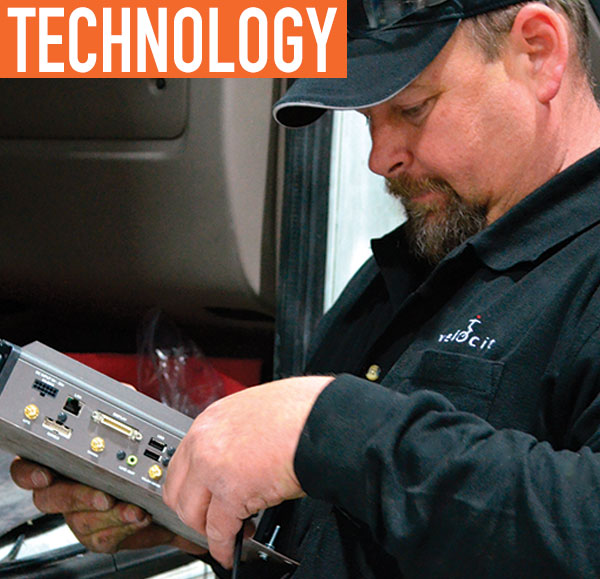There is an old saying that rings true for all types of fleets, every day: “Time is money.” As fleet executives also know, when a vehicle is out of service there are significant costs beyond just the expense of parts and labor. From a total cost of ownership perspective, fleet operators also consider lost revenue and the impact on customer satisfaction that is directly related to vehicle downtime.
“Cost and time are also important considerations when it comes to deploying the variety of aftermarket technologies that many fleets are now using to improve efficiency, productivity, and safety,” says Deryk Powell, president of Velociti, the provider of transportation and networking technology deployment services. “While it may be easy to quantify the value of a technology investment, your return on investment on what is likely a considerable amount of capital will also be impacted by the time it takes to deploy and support a solution.
There is an old saying that rings true for all types of fleets, every day: “Time is money.” As fleet executives also know, when a vehicle is out of service there are significant costs beyond just the expense of parts and labor. From a total cost of ownership perspective, fleet operators also consider lost revenue and the impact on customer satisfaction that is directly related to vehicle downtime.
“Cost and time are also important considerations when it comes to deploying the variety of aftermarket technologies that many fleets are now using to improve efficiency, productivity, and safety,” says Deryk Powell, president of Velociti, the provider of transportation and networking technology deployment services. “While it may be easy to quantify the value of a technology investment, your return on investment on what is likely a considerable amount of capital will also be impacted by the time it takes to deploy and support a solution.
“The longer it takes to deploy a technology, the longer before the ROI can be realized,” Powell continues, “and for any type of aftermarket technology, it’s also important to consider more than just the time it takes for installation. That’s especially true today, because the complexity of new vehicles and the ongoing shortage of trained technicians can make effectively managing even routine maintenance and repair operations increasingly more challenging.”
Ancillary technology products, whether included as part of an OEM build specification or added in the aftermarket, have become increasingly common. Examples include GPS tracking systems, in-cab tablets/printers/scanners for workflow management, video monitoring systems, driver behavior systems, collision warning and lane departure systems, tire inflation or monitoring systems, light bars and solar panels—and more are added to that list every day.
An aftermarket technology deployment, Powell notes, is not a series of tasks but a project that can involve a considerable amount of management time to plan and execute. He estimates that on average, 10 percent of the effort that goes into an aftermarket deployment is for project management activities.
Powell also provides a list of factors fleets should consider. Included is the need to schedule installations with as little disruption to daily operations as possible and to manage inventory so components and systems are on hand where and when they are needed. Additionally, technician training and special tools, installation guides, pilot installations to validate processes, and for fleets with multiple makes and models of vehicles, different mounting brackets and techniques, may all be required.

Featured Image: A tech installs Velociti’s technology on a Border States Electric truck.
Above: Velociti teams completed the first 106 vehicles and conducted training at 21 sites, followed by installations and training on 224 remaining units at 59 additional sites.
A CASE IN POINT
From 80 locations in 16 states, Border States Electric supplies products and services to construction, industrial, and utility customers. When the wholesale distributor decided to deploy the JJ Keller E-Log System, which consists of an electronic logging solution and a fixed mount for the JJ Keller Compliance Tablet, as well as the DriveCam video event recorder based on-board driver safety system, it turned to Velociti to handle the installation challenge. Additionally, the company needed to schedule training on the new systems simultaneously with the installations to minimize downtime and to maximize productivity, as well as user acceptance.
Velociti provided Border States Electric with a comprehensive deployment solution that included project management, concurrent installations and training, inventory management, and real-time testing and verification. The process began with pilot mounting options to ensure correct and consistent solutions for a variety of vehicle types, including International and Kenworth tractors, Ford and GMC pick-ups, and Dodge vans. The pilot test was also used as a time study to build the deployment schedule.
Once the study was completed, it was determined that multiple phases would be required to meet the complex schedule and scope of the project. Since Velociti’s technicians are trained on a wide range of technology solutions, they were able to install the DriveCam units simultaneously with JJ Keller E-Log system in 330 vehicles. Velociti teams completed the first 106 vehicles and conducted training at 21 sites in two months, followed by installations and training on 224 remaining units at 59 additional sites.

PROVIDING VISIBILITY
Velociti’s ability to provide a rapid deployment solution along with flexible scheduling allowed Border States Electric to meet all of its installation and training needs and realize a faster ROI from the aftermarket solutions. “Proper planning is essential to the success of any deployment,” Powell states, “along with the ability to provide visibility into a project’s progression. Project updates should never be another project to manage.”
To accomplish that goal for fleets, Velociti has designed the Velogic online project management tool. The portal provides instant access to all aspects of a deployment, from tracking device shipments to seeing which products have been installed at specific locations or on specific vehicles. Included are daily and summary reports.
Equally important, according to Powell, is to support aftermarket technologies. Velociti’s post installation services, he notes, uses service experts to troubleshoot and resolve technology issues remotely by phone, as well as on-site. Velociti also works with technology providers on behalf of fleet customers. The point-based solution is available for a monthly per-vehicle fee.
“You’re making an investment in aftermarket technologies for a prescribed return,” Powell says, “but if you just deploy it and don’t ensure it continues to perform effectively, you can easily undermine the savings you’re hoping to realize. The time required to deploy and support aftermarket technologies, especially on a mix of makes and models of vehicles at multiple locations, can have a definite impact on the ROI and on maintenance and downtime costs.”

ABOUT THE AUTHOR:
Seth Skydel has more than 30 years of truck related publication experience. He has held editorial roles at numerous national business-to-business publications focusing on fleet and transportation management, vehicle and information technology, and industry trends and issues.
_______________________________________________________________________
MODERN WORKTRUCK SOLUTIONS: JUNE 2016 ISSUE
Did you enjoy this article?
Subscribe to the FREE Digital Edition of Modern WorkTruck Solutions magazine.
![]()




